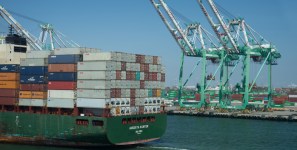No USWC Port Labor Contract Worries Retailers
Washington, DC – Import cargo volume at the nation’s major retail container ports is expected to see a final surge and set a new monthly record in October as the holiday season approaches, according to the National Retail Foundation’s monthly Global Port Tracker report.
“Increasing congestion at the nation’s ports, as well as the ongoing West Coast labor negotiations, are ongoing concerns and retailers are making one last push to make sure they’re stocked up for the holidays,” said Jonathan Gold, the NRF’s vice president for Supply Chain and Customs Policy.
“Retailers are working hard to make sure customers can find what they’re looking for regardless of what happens at the ports.”
The contract between the Pacific Maritime Association (PMA) and the International Longshore and Warehouse Union (ILWU) affecting cargo movement at US West Coast (USWC) ports expired on July 1, prompting concerns among the nations’s retailers and others about potential disruptions that could affect back-to-school or holiday merchandise.
The Washington, DC-based NRF recently sent a letter to the heads of the PMA and the ILWU urging a speedy, successful conclusion to their on-going negotiations.
Dockworkers remain on the job as negotiations continue but the lack of a contract and operational issues “have led to record congestion” at ports from Seattle to San Diego, the industry group said.
“Finalizing a new labor contract is an absolutely critical component to working through the backlog of shipping containers now piling up at West Coast ports,” the letter read. “We are deeply troubled by the fact that no apparent progress has been made in the negotiations since August, when the PMA and ILWU announced a ‘tentative deal’ on health benefits.”
The NRF, the largest retail industry group in the world, chided both groups for their lack of transparency, saying that, “Whether intentional or not, the fact that neither the PMA nor ILWU has made any public progress report in more than a month is sending a very troublesome and disconcerting signal.”
Shippers, the NRF said, “look for certainty when making strategic long-term supply chain investments, or for placing transportation orders for discretionary cargo.”
The ongoing negotiations “and the degradation of operating efficiency, specifically at the ports of Los Angeles and Long Beach, is making the region unattractive for future investment and will lead to a permanent shift of cargo,” the letter concluded.
Import volume at US ports covered by the Global Port Tracker report is expected to total 1.53 million containers this month, topping the 1.52 million monthly record set in August. Cargo volume has been well above average each month since spring as retailers have imported merchandise early in case of any disruption on the docks.
The 1.52 million TEUs (Twenty-Foot Equivalent Unit cargo containers) handled in August, the latest month for which after-the-fact numbers are available, was up 1.5 percent from July and 2.1 percent from August 2013.
The import numbers come as NRF is forecasting 4.1 percent holiday season sales growth and 3.6 percent growth for all of 2014.
Global Port Tracker, which is produced for NRF by the consulting firm Hackett Associates, covers the ports of Los Angeles/Long Beach, Oakland, Seattle and Tacoma on the US West Coast; New York/New Jersey, Hampton Roads, Charleston, Savannah, Port Everglades and Miami on the US East Coast, and Houston on the US Gulf Coast.
10/10/2014





Leave a Reply